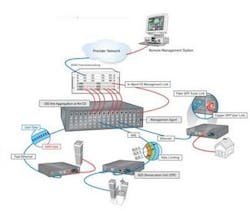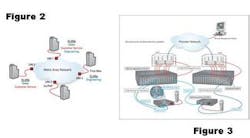Optical Ethernet bridges the gap from provider to customer
Until recently, Ethernet was not considered a viable alternative to existing access solutions -- but a new standard promises to make believers out of service providers.
By Todd Rope and Troy Larsen
MRV Communications Inc.
The initiatives of the Metro Ethernet Forum and the newly ratified IEEE 802.3ah standard are giving credibility to Ethernet as a viable option for first-mile access. The defining of subscriber access topologies, copper and fiber physical layer specifications, and common operations, administration, and maintenance (OAM) support enable service providers to reduce capital and operating expenses while expanding revenue-generating service offerings.
The IEEE 802.3ah standard addresses the needs of service providers while bringing the benefits of Ethernet to the challenge of first-mile deployment. The term "first mile," of course, refers to the important link connecting the service provider with the business or residential subscriber. Existing approaches have faced a number of significant challenges, including performance bottlenecks, limited bandwidth upgrades, configuration complexity, and expense. For those reasons, Ethernet is now being considered as a viable alternative.
From humble beginnings to new standards
Ethernet first emerged as a broadcast LAN technology where, as a "best effort" delivery protocol, the occasional frame disruption, caused by collisions or signal noise, was expected and tolerated. Aside from these limitations, however, it was soon discovered that Ethernet offered much more promise to the telecom industry.
Today, Ethernet is globally ubiquitous. It is easily configured, cost-effective, highly scalable, and supportive of a wide range of services, including data, voice, and video. With the final draft now in place, the Ethernet in the First Mile (EFM) IEEE 802.3ah standard defines three subscriber access topologies and the associated physical layer specifications.
For copper topologies, it offers point-to-point access over voice-grade copper cabling with a speed of 10 Mbits/sec at a distance of 750 m, or 2 Mbits/sec at 2,700 m. As a point-to-multipoint architecture, an Ethernet passive optical network (EPON) uses singlemode fiber-optic cabling to achieve a speed of 1 Gbit/second at distances of up to 10 km. Ethernet also enables point-to-point over singlemode or multimode fiber using one or two fibers. Speeds range from 100 Mbits/sec to 1 Gbit/sec at distances of 10 km or more for singlemode and 550 m for multimode.
The OAM portion of 802.3ah provides network operators with the mechanisms to monitor network health and quickly determine the location of failing links or fault conditions. It uses a minimal in-band packet exchange to provide service module and customer premises equipment (CPE) information, event notification, variable retrieval, and loopback controls. The standard will also allow vendors to add extensions to support additional features and issues not covered.
Service demarcation
One application of 802.3ah can be defined as Optical Ethernet Services (OES) demarcation. This type of system enables service providers to offer cost-effective fiber-to-the-premises (FTTP) services that, while providing comprehensive OAM capabilities, remain compatible with existing central office (CO) internetworking equipment. In essence, the carrier is able to deploy the simplest form of optical Ethernet service -- a "clear" Ethernet link having a well-defined demarcation point (Figure 1).
An OES demarcation system creates fully managed Ethernet/Fast Ethernet or Gigabit Ethernet point-to-point fiber-optic first-mile access links. It provides remote management of multiple links end-to-end using a single CO management entity with only one IP address, significantly streamlining the task of network administration. Plug-and-play OES demarcation translates into quicker, on-demand deployment, less onsite time, and more efficient use of available resources -- a big savings on capital expenses.
Operational expenses are also decreased since the optical OES demarcation system provides complete control over the CPE from anywhere on the provider network. The ability to remotely monitor, diagnose, and provision the CPE reduces the number of truck rolls needed for onsite service while enhancing customer satisfaction.
Beyond the standards
An OES demarcation system can extend the 802.3ah standard with additional features and functionality that further benefit both the service provider and subscriber.
SFP interfaces: Small form-factor pluggable (SFP) interfaces are a new style of optical physical layer interface that can be swapped out to allow changes to be made to the network type. OES demarcation devices that are SFP-enabled offer unmatched deployment flexibility. For instance, the same demarcation unit can be used for multimode, singlemode, and single fiber connections, or even shared physical fiber CWDM or DWDM connections -- all simply depending on the SFP interface employed.
With SFP interfaces, more expenses are avoided by making it possible for the network to accommodate a wide range of applications with a relatively small number of components. This inventory reduction means that equipment can be purchased on an "as needed" basis.
Optical performance monitoring (OPM): An OES demarcation system that supports SFP digital diagnostics as per the SFF-8472 standard provides a powerful OPM tool for accessing a number of real-time SFP operating parameters. The information provided by digital diagnostics, along with alarm and warning thresholds, enables a network administrator to identify a potential connection problem and take preemptive action before any service outage occurs.
Layer 2 protocol transparency: Multi-location enterprise networks interconnected over the MAN employ switching management protocols that coordinate the functionality of multiple switching systems. Examples of these protocols include Spanning Tree (802.1D/Q), Link Aggregation (802.1ad), and Port Control (802.1ab)
In general, LAN service over a MAN requires full Layer 2 bridge protocol data unit (BPDU) transparency by the OES demarcation system to allow Ethernet switches residing at the different geographical locations to be managed like a single virtual switched network (Figure 2).
Long packet support: The maximum size for IEEE standard Ethernet frames is 1,522 bytes (802.1Q tagged frames). However, many Ethernet and IP switch/routers make use of proprietary (or de-facto standard) extensions that result in a larger maximum frame size. Today these protocols, such as Cisco ISL, VTP, CDP, and UTI/L2TPV3, run predominantly in the LAN. However, the emergence of multi-location LAN services increases the occurrence of these protocols operating across the MAN.
For carriers, it is becoming essential that any EFM service such as OES demarcation be able to accommodate these extended Ethernet frames. Emerging protocols for transparent LAN services accept the fact that in full-duplex mode Ethernet does not have any practical packet size limit and thus are extending frames to well beyond the sweet spot of 1,600 bytes and towards the mini-jumbo limits of 2,000 bytes. In the future, jumbo-sized packets that extend to 9,000 bytes are even possible.
Self-healing/redundant links: Subscribers with mission-critical applications benefit from OES demarcation platforms with self-healing/redundant trunk link capabilities (Figure 3). Self-healing applies when the CPE module is doubly connected to one CO (single homing) or singly connected to two COs (dual homing). If the primary trunk link fails, the CPE automatically switches to the secondary connection. With a switchover time of < 50 msec, the event remains transparent to the network with minimal packet loss.
Link state propagation: With an OES demarcation system that supports some form of link state propagation, a service provider can ensure maximum uptime for subscribers. The system is designed to correctly communicate the current state of the first-mile link to both the provider and subscriber networks. For example, if a link is lost on the fiber trunk between the CO and CPE, the OES demarcation units at each end automatically disable all their interfaces. This has the effect of propagating the loss of link to any connected switch or router, allowing those devices to react and change to an alternate route.
Rate limiting: Rate limiting enables service providers to create multi-tiered service level agreements (SLAs) whereby bandwidth is allocated to meet a subscriber's current requirements and scaled up (or down) as needs change. Because the change corresponds to an adjustment in service fees, both parties benefit. The finer the rate-limiting granularity of the OES demarcation system, the greater its SLA flexibility will be. With CPE remote management capabilities, the rate can be configured on demand with no hardware change-out or truck roll being necessary.
Remote software download: As standards evolve and new features become available, updating equipment in the field becomes important to the service provider -- a potentially time-consuming and expensive proposition. With an OES demarcation approach that supports the remote download of firmware and microcode, system upgrades can be accomplished with absolute minimal service disruption. With no need to dispatch personnel into the field to perform the upgrade, both time and money will be saved.
Why Ethernet access?
Since Ethernet is a relatively simple and cost-effective technology that provides plug-accessibility at any point-of-presence, it is turning many a head among today's service providers. It is a well-suited technology for bridging the gap between provider and subscriber networks. For carriers seeking 99.999% availability, application awareness, and quality of service (QoS) from the demarcation point forward, Ethernet in the First Mile has come of age.
SLAs must guarantee flexibility in providing Internet access, point-to-point services, multipoint-to-multipoint services, circuit emulation services, and security services directly from the Ethernet demarcation points to reduce total cost of ownership. In addition, they must operate over different physical infrastructures -- single fiber, singlemode fiber, multimode fiber, Category 5, and telephone lines -- to provide the optimal Ethernet access. Today's EFM offerings are meeting these and other challenges.
Ethernet hand-off
The subscriber edge of the network is where QoS shows its value -- and it's at this point that the network physical and logical connection handoff occurs between the customer and the carrier. EFM equipment can be deployed along with sophisticated QoS and congestion control functions.
In the case of an OES demarcation system, the service does not preclude the additional deployment of, say, MPLS. However, no commitment (and thus inherent liability) is necessary on the part of the service provider for application QoS or security implementation at the demarcation point. The service provider leaves the full management of the customer Intranet to the customer.
Today's service providers across the spectrum aspire to connect multiple sites over cost-effective, scalable, point-to-point or point-to-multipoint internal networks. Their applications include LAN connectivity, PBX interconnection, and special applications beyond storage, disaster recovery, and backup. As this trend continues, it is clear that a huge business opportunity is emerging for using Ethernet in the First Mile as the means to achieve scalability, reliability, and cost-effective services.
Todd Rope is vice president of technology and Troy Larsen is technical marketing manager at MRV Communications (www.mrv.com), headquartered in Chatsworth, CA.


